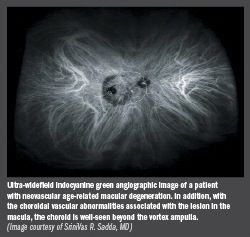Article
Future of retinal imaging advancing on multiple fronts
Retinal imaging is rapidly advancing with the introduction of novel technologies and new imaging techniques.
TAKE HOME:
Retinal imaging is rapidly advancing with the introduction of novel technologies and new imaging techniques.

Dr. Sadda
By Cheryl Guttman Krader; Reviewed by SriniVas R. Sadda, MD
Los Angeles-Retinal imaging has entered a golden era in which a number of new techniques and technologies have recently become commercially available or around the corner, said SriniVas R. Sadda, MD.
“We have seen rapid advances in retinal imaging over the past decade that have dramatically transformed our practices, and we can expect the pace of these advances to accelerate over the next decade,” said Dr. Sadda, professor of ophthalmology, University of Southern California, and director, Doheny Image Reading Center, Doheny Eye Institute, Los Angeles.
“I feel it is an exciting time to be an ophthalmologist, and I hope others share this excitement,” he said.
Noting that the number of developments makes it impossible to discuss them all, Dr. Sadda chose to focus on swept-source optical coherence tomography (OCT), OCT angiography, and wide-field angiography as techniques that are currently or soon to be in use.

Photoacoustic imaging
However, he began by highlighting photoacoustic imaging as an example of very novel technology.
Unlike other imaging technologies that identify differences in light reflection by ocular tissues, photoacoustic imaging is based on differences in light absorption. Light absorption leads to tissue heating, resulting in tissue expansion and the creation of pressure waves that are detected with a transducer to allow imaging.
“Photoacoustic imaging is great for studying tissues containing chromophores that absorb light, like the retinal blood vessels and the retinal pigment epithelium (RPE),” Dr. Sadda said. “It allows the blood vessels to be seen in brilliant detail and the RPE mosaic to be visualized as well when coupled with adaptive optics. It is hoped that in the future it will be very useful for evaluating RPE function.”
Swept-source OCT
The latest generation of commercially available Fourier-domain OCT technology includes swept-source OCT platforms. Advantages of swept-source OCT include faster speed and better sensitivity, particularly in the evenness of the sensitivity as one moves away from the zero-delay line (typically at the top of the image).
The high speed of swept-source OCT minimizes concerns with fixation and more importantly enables wider angle imaging and averaging of these larger areas with high resolution.
“Some research instruments are capable of megahertz scanning, which offers the possibility to generate images with 4-megapixel resolution and at whatever depth or plane that we want,” Dr. Sadda said. “With swept-source OCT, we can get very dense volume scans that yield images resembling those of fundus photographs, but with the advantage of being depth resolved.”
The reduced sensitivity loss with greater depth is allowing imaging of the outer retina in greater detail. Some research instruments allow visualization of the photoreceptor outer segment mosaic even without adaptive optics, Dr. Sadda noted.
Since the swept-source OCT devices operate at a longer wavelength than earlier-generation OCT systems, they also have the ability to penetrate into deeper ocular structures, which may obviate the need for other enhanced depth imaging strategies.
“I can foresee many advantages for using this type of an approach for studies of the choroid,” Dr. Sadda said. “The great thing is that with swept -source OCT, we are able to image the vitreous and the choroid simultaneously with the same level of detail.”
He added that glaucoma specialists are excited about using this technology for optic nerve head imaging where it can be used to see details of the lamina cribosa.
OCT angiography is already available for studying the retinal and choroidal microvasculature and is being developed using different strategies, including a phase-contrast approach and a split-spectrum amplitude decorrelation technique.
Wide-field imaging strategies are expanding to indocyanine green angiography and OCT. The latter provides a high-resolution, large view of the retina with a non-contact exam.
SriniVas R. Sadda, MD
E: ssadda@doheny.org
Dr. Sadda is a consultant to and receives research support from Carl Zeiss Meditec and Optos.
Subscribe to Ophthalmology Times to receive the latest clinical news and updates for ophthalmologists.
Newsletter
Don’t miss out—get Ophthalmology Times updates on the latest clinical advancements and expert interviews, straight to your inbox.




